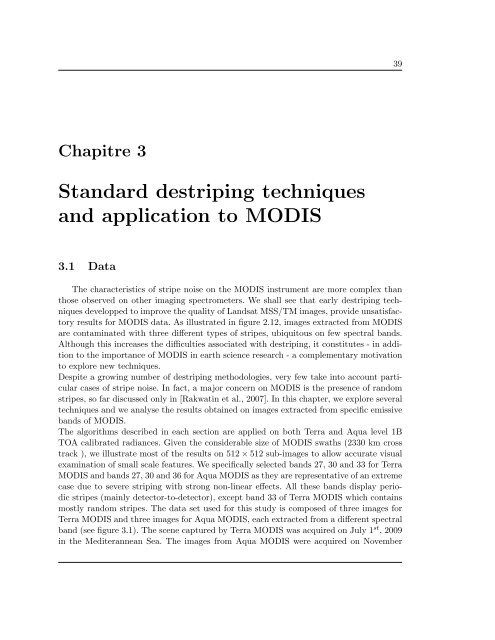Th`ese Marouan BOUALI - Sites personnels de TELECOM ParisTech
Th`ese Marouan BOUALI - Sites personnels de TELECOM ParisTech
Th`ese Marouan BOUALI - Sites personnels de TELECOM ParisTech
Create successful ePaper yourself
Turn your PDF publications into a flip-book with our unique Google optimized e-Paper software.
39<br />
Chapitre 3<br />
Standard <strong>de</strong>striping techniques<br />
and application to MODIS<br />
3.1 Data<br />
The characteristics of stripe noise on the MODIS instrument are more complex than<br />
those observed on other imaging spectrometers. We shall see that early <strong>de</strong>striping techniques<br />
<strong>de</strong>velopped to improve the quality of Landsat MSS/TM images, provi<strong>de</strong> unsatisfactory<br />
results for MODIS data. As illustrated in figure 2.12, images extracted from MODIS<br />
are contaminated with three different types of stripes, ubiquitous on few spectral bands.<br />
Although this increases the difficulties associated with <strong>de</strong>striping, it constitutes - in addition<br />
to the importance of MODIS in earth science research - a complementary motivation<br />
to explore new techniques.<br />
Despite a growing number of <strong>de</strong>striping methodologies, very few take into account particular<br />
cases of stripe noise. In fact, a major concern on MODIS is the presence of random<br />
stripes, so far discussed only in [Rakwatin et al., 2007]. In this chapter, we explore several<br />
techniques and we analyse the results obtained on images extracted from specific emissive<br />
bands of MODIS.<br />
The algorithms <strong>de</strong>scribed in each section are applied on both Terra and Aqua level 1B<br />
TOA calibrated radiances. Given the consi<strong>de</strong>rable size of MODIS swaths (2330 km cross<br />
track ), we illustrate most of the results on 512 × 512 sub-images to allow accurate visual<br />
examination of small scale features. We specifically selected bands 27, 30 and 33 for Terra<br />
MODIS and bands 27, 30 and 36 for Aqua MODIS as they are representative of an extreme<br />
case due to severe striping with strong non-linear effects. All these bands display periodic<br />
stripes (mainly <strong>de</strong>tector-to-<strong>de</strong>tector), except band 33 of Terra MODIS which contains<br />
mostly random stripes. The data set used for this study is composed of three images for<br />
Terra MODIS and three images for Aqua MODIS, each extracted from a different spectral<br />
band (see figure 3.1). The scene captured by Terra MODIS was acquired on July 1 st , 2009<br />
in the Mediterannean Sea. The images from Aqua MODIS were acquired on November















